Looking for a student learning guide? It’s on the main menu for your course. Use the “Courses” menu above.
Introduction: Introductory Video
1. Interactive Reading 1: Introducing Cells
[qwiz qrecord_id=”sciencemusicvideosMeister1961-intro-to-cells (AP)I.R” style=”width: 550px !important; min-height: 400px !important;”]
[h] Interactive Reading 1: Introducing Cells
[i] One of the key properties of life is that living things, like this bacterium, are made of cells. Read what follows to learn about the basic features of these basic units of life.
[q labels = “top”]
Cells are the ______________________. Anywhere you go on our planet, you can be sure that if you see something that’s alive, it’s made of ________.
Life has existed on Earth for about 3.5 billion years. For about 2 billion years, all life consisted of prokaryotic cells. This kind of cell is found today in bacteria. Bacteria include what are commonly called _________, as well as cells that live in the soil, the oceans, on your skin, in your intestines, and just about everywhere else.
[l]germs
[f*] Correct!
[fx] No. Please try again.
[l]basic units of life
[f*] Correct!
[fx] No. Please try again.
[l]cells
[f*] Correct!
[fx] No, that’s not correct. Please try again.
[q multiple_choice=”true”] Prokaryotic cells are the smallest, simplest cells (though they’re still enormously complex). These cells are about 10 millionths of a meter long. For now, we’re just going to focus on three of their parts, parts which are also found in all other cells.
All cells have a chromosome, shown at number 3. Chromosomes are made of DNA, the molecule that tells the cell what to do. A cell inherits its DNA from its parent cell. When a cell reproduces, it passes copies of its chromosomes to its offspring. Surrounding the chromosome is a gel-like fluid called the cytoplasm, shown at number 2. The cytoplasm is where the thousands of chemical reactions that are needed to keep life going are occurring. Surrounding the cytoplasm is the cell’s membrane, shown at number 1. The membrane controls what enters and leaves the cell.
Answer this question to continue: The cell’s DNA is found in its
[c]IGN5dG9wbGFzbQ==[Qq]
[f]IE5vcGUuIEROQSBpcyBmb3VuZCBpbiB0aGUgY2VsbCYjODIxNztzIGNocm9tb3NvbWU=[Qq]
[c]IGNocm9t b3NvbWU=[Qq]
[f]IFllcy7CoEROQSBpcyBmb3VuZCBpbiB0aGUgY2VsbCYjODIxNztzIGNocm9tb3NvbWU=[Qq]
[c]IG1lbWJyYW5l[Qq]
[f]IE5vLkROQSBpcyBmb3VuZCBpbiB0aGUgY2VsbCYjODIxNztzIGNocm9tb3NvbWU=
Cg==[Qq]
[q labels = “top”]Just to make sure you’ve got it, label the parts in the diagram below.
[l]chromosomes/DNA
[f*] Excellent!
[fx] No. Please try again.
[l]cytoplasm
[f*] Good!
[fx] No, that’s not correct. Please try again.
[l]cell membrane
[f*] Correct!
[fx] No, that’s not correct. Please try again.
[q labels = “top”]Connecting parts with functions
[l]chemical reactions
[f*] Correct!
[fx] No, that’s not correct. Please try again.
[l]controls what enters and leaves
[f*] Correct!
[fx] No, that’s not correct. Please try again.
[l]hereditary material/survival instructions
[f*] Great!
[fx] No. Please try again.
[q multiple_choice=”true”] Which part of the cell controls what enters and leaves the cell?
[c]IGN5dG9wbGFzbQ==[Qq]
[f]IE5vcGUuIFRoZSBjeXRvcGxhc20gaXMgd2hlcmUgdGhlIGNlbGwmIzgyMTc7cyBjaGVtaWNhbCByZWFjdGlvbnMgYXJlIG9jY3VycmluZy4=[Qq]
[c]IGNocm9tb3NvbWU=[Qq]
[f]IE5vLsKgVGhlIGNocm9tb3NvbWUgaXMgd2hlcmUgdGhlIEROQSBpcyBmb3VuZC4=[Qq]
[c]IG1lbW JyYW5l[Qq]
[f]IEV4Y2VsbGVudC4gVGhlIG1lbWJyYW5lIGNvbnRyb2xzIHdoYXQgZW50ZXJzIGFuZCBsZWF2ZXMgdGhlIGNlbGwu
Cg==[Qq]
[q multiple_choice=”true”] Most of the chemical reactions that keep the cell alive are occurring in the
[c]IGN5dG9w bGFzbQ==[Qq]
[f]IFllcy4gVGhlIGN5dG9wbGFzbSBpcyB3aGVyZSB0aGUgY2VsbCYjODIxNztzIGNoZW1pY2FsIHJlYWN0aW9ucyBhcmUgb2NjdXJyaW5nLg==[Qq]
[c]IGNocm9tb3NvbWU=[Qq]
[f]IE5vLsKgVGhlIGNocm9tb3NvbWUgaXMgd2hlcmUgdGhlIEROQSBpcyBmb3VuZC4=[Qq]
[c]IG1lbWJyYW5l[Qq]
[f]IE5vLiBUaGUgbWVtYnJhbmUgY29udHJvbHMgd2hhdCBlbnRlcnMgYW5kIGxlYXZlcyB0aGUgY2VsbC4=[Qq]
[x]
[restart]
[/qwiz]
2. Interactive Reading 2: Eukaryotic Cells, the Cell Theory, Unicellular v. Multicellular, and Viruses
[qwiz style=”width: 550px !important; min-height: 400px !important;” qrecord_id=”sciencemusicvideosMeister1961-intro-to-cells-2 (AP)I.R.”]
[h]Interactive Reading: Cell Theory, Unicellular v. Multicellular, and Viruses
[i]
[q labels = “top”]
The cells that make up you and me are more complex than the prokaryotic cells that you read about above. You can see some of this ________________ in the diagram to your left, which shows an animal cell.
Animal cells, like the cells that make up plants and fungi, are eukaryotic. Like prokaryotic cells, eukaryotic cells have a _____________ (2), ______________ (1), and chromosomes (4).
[l]complexity
[fx] No. Please try again.
[f*] Great!
[l]cytoplasm
[fx] No. Please try again.
[f*] Great!
[l]membrane
[fx] No, that’s not correct. Please try again.
[f*] Good!
[q]Eukaryotic cells are different from prokaryotic cells in the following ways:
- Eukaryotic cells are much larger than prokaryotic cells: about 10 times as big.
- Eukaryotic cells are more complex. Inside a eukaryotic cell are numerous organelles. Organelles are cell parts that are surrounded by their own membrane, and which carry out specific functions. Parts 3, 7, 8, and 9 in the diagram are organelles that we’ll learn about later in this course.
- The chromosomes (4) in a eukaryotic cell are enclosed in a protective nucleus (5).
True or false: Both prokaryotic and eukaryotic cells have a nucleus.
[c]VHJ1ZQ==[Qq]
[c]RmFs c2U=[Qq]
[f]Tm8uIFByb2thcnlvdGljIGNlbGxzIGhhdmUgRE5BLCBidXQgbm90IGEgbnVjbGV1cy4=[Qq]
[f]Q29ycmVjdC4gT25seSBldWthcnlvdGljIGNlbGxzIGhhdmUgYSBudWNsZXVzLg==[Qq]
[q]True or false: Eukaryotic cells are larger than prokaryotic cells
[c]VHJ1 ZQ==[Qq]
[c]RmFsc2U=[Qq]
[f]WWVzLiBFdWthcnlvdGljIGNlbGxzIGFyZSBib3RoIGxhcmdlciBhbmQgbW9yZSBjb21wbGV4IHRoYW4gcHJva2FyeW90aWMgY2VsbHMu[Qq]
[f]Tm8uIFRoZSBzdGF0ZW1lbnQgYWJvdmUgaXMgZmFsc2UuwqBFdWthcnlvdGljIGNlbGxzIGFyZSBib3RoIGxhcmdlciBhbmQgbW9yZSBjb21wbGV4IHRoYW4gcHJva2FyeW90aWMgY2VsbHMu[Qq]
[q labels = “top”]
In the 1600s, using a very early microscope, Robert Hooke examined very thin slices of cork (bark). He observed the rectangular structures you can see in his drawing on left and called them cells.
Over the next few hundred years, observations about cells led to the cell theory. The cell theory states that:
- Cells are the _____________________
- All living things are ______________________________ cells
- All cells come from _______________________, living cells.
[l]made up of one or more
[fx] No. Please try again.
[f*] Excellent!
[l]basic units of life.
[fx] No. Please try again.
[f*] Good!
[l]other, pre-existing
[fx] No, that’s not correct. Please try again.
[f*] Great!
[q]Many living things are composed of just one cell. These organisms are said to be unicellular. Just remember that a unicycle has one wheel, and you’ll be able to remember that unicellular means “single-celled.”
Organisms like people, fence lizards, oak trees, and bread mold are composed of many cells: trillions, in the case of humans and other animals. Organisms composed of many cells are said to be multicellular. If you remember that the prefix “multi” means “many” (as in multitude, multiply, multicolored, and multiplex) you’ll be able to remember multicellular.
True or false: Cats are unicellular
[c]VHJ1ZQ==[Qq]
[c]RmFs c2U=[Qq]
[f]Tm8uIFRoZSBzdGF0ZW1lbnQgJiM4MjIwO2NhdHMgYXJlIHVuaWNlbGx1bGFyJiM4MjIxOyBpcyBGQUxTRS4gSWYgYSBjYXQgd2VyZSB1bmljZWxsdWxhciwgaXQgd291bGQgYmUgbWFkZSBvZiBqdXN0IG9uZSBjZWxsLiBDYXRz[Qq]
[f]Q29ycmVjdC4gQW4gb3JnYW5pc20gYXMgYmlnIGFuZCBhcyBjb21wbGV4IGFzIGEgY2F0IGhhcyB0byBiZSBtdWx0aWNlbGx1bGFyLg==[Qq]
[q]True or false: Cats are eukaryotic
[c]VHJ1 ZQ==[Qq]
[c]RmFsc2U=[Qq]
[f]WWVzLiBBbGwgYW5pbWFscyBhcmUgZXVrYXJ5b3RpYy4=[Qq]
[f]Tm8uwqBQcm9rYXJ5b3RpYyBvcmdhbmlzbXMgYXJlIGFsbCBleHRyZW1lbHkgc21hbGwsIGFuZCBzaW5nbGUtY2VsbGVkLg==[Qq]
[q]
Finally, a word about viruses. In this context of introducing cells as the basic units of life, here’s what you need to know about how viruses fit in.
- Viruses are tiny particles that infect cells, and then use the cells they infect to make more viruses.
- Viruses are much simpler and smaller than even the smallest cells. The average virus is about 1/100th the size of the average bacterial cell.
- Viruses themselves are not made of cells. They consist of genetic material (DNA, or a closely related molecule called RNA), surrounded by a coat of protein that enables them to bind with and infect cells. There might be additional layers of material outside the protein.
Viruses might seem to be exceptions to the cell theory, but they’re not. Even though viruses can reproduce, they’re not considered to be independent living things. We’ll take a look at viruses again later in this course,
[q]True or false: Viruses are prokaryotic
[c]VHJ1ZQ==[Qq]
[c]RmFs c2U=[Qq]
[f]Tm8uIFZpcnVzZXMgYXJlIG5laXRoZXIgZXVrYXJ5b3RpYyBub3IgcHJva2FyeW90aWMuIFRoZXkmIzgyMTc7cmUgbm90IG1hZGUgb2YgY2VsbHMsIHNvIG5laXRoZXIgb2YgdGhvc2UgZGVmaW5pdGlvbnMgZml0Lg==[Qq]
[f]Q29ycmVjdC4gVmlydXNlcyBhcmUgbmVpdGhlciBldWthcnlvdGljIG5vciBwcm9rYXJ5b3RpYy4gVGhleSYjODIxNztyZSBub3QgbWFkZSBvZiBjZWxscywgc28gbmVpdGhlciBvZiB0aG9zZSBkZWZpbml0aW9ucyBmaXQu[Qq]
[x]
[restart]
[/qwiz]
3. Flashcards: Some cell-related vocabulary
[qdeck style=”width: 550px !important; min-height: 400px !important;” qrecord_id=”sciencemusicvideosMeister1961-intro-cells (AP)F.C.”]
[h] Flashcards: Cell Vocabulary
[i] If you haven’t used a set of flashcards on this website before, here’s what you need to know.
- Click ‘Check Answer’ to see the answer to each card.
- If you know it, click ‘Got it.”
- If you don’t know it as well as you’d like, click ‘Need more practice,’ and that card will go to the bottom of the deck so you can practice it again.
- YOU’LL LEARN MORE IF YOU’RE STRICT WITH YOURSELF. Only click “Got It!” if you truly know the answer.
- ‘Shuffle’ lets you shuffle the deck.
[!]Card 1++++++++++++++++++++++++++++++++++++++++++++++++[/!]
[q] What are the small units that are the basic units of life?
[a] The small units that are the basic units of life are cells.
[!] CARD 2++++++++++++++++++++++++++++++++++[/!]
[q] The genetic material inside cells is ____________.
[a] The genetic material inside cells is DNA.
[!] CARD 3++++++++++++++++++++++++++++++++++[/!]
[q] The fluid inside cells where chemical reactions occur is the ____________.
[a] The fluid inside cells where the chemical reactions occur is the cytoplasm
[!] CARD 4++++++++++++++++++++++++++++++++++[/!]
[q] According to the cell theory, the basic unit of structure and function in living things is the ____________.
[a]According to the cell theory, the basic unit of structure and function in living things is the cell.
[!] CARD 5++++++++++++++++++++++++++++++++++[/!]
[q] According to the cell theory, all cells come from other ____________.
[a]According to the cell theory, all cells come from other cells.
[!] CARD 6++++++++++++++++++++++++++++++++++[/!]
[q] According to the cell theory, all living things are composed of one or more ____________.
[a]According to the cell theory, all living things are composed of one or more cells.
[!] CARD 7++++++++++++++++++++++++++++++++++[/!]
[q] Small cells which lack a nucleus and complex organelles are called ____________.
[a]Small cells which lack a nucleus and complex organelles are called prokaryotic.
[!] CARD 9++++++++++++++++++++++++++++++++++[/!]
[q] Larger cells with a nucleus and complex organelles are called ____________.
[a]Larger cells with a nucleus and complex organelles are called eukaryotic.
[!] CARD 10++++++++++++++++++++++++++++++++++[/!]
[q]Are the cells found in bacteria (germs and other organisms) prokaryotic or eukaryotic? ____________.
[a]The cells in bacteria are prokaryotic.
[!] CARD 10a++++++++++++++++++++++++++++++++++[/!]
[q]An infectious particle that is not made of cells, but which can reproduce by infecting and taking over cells, is a _______________.
[a]An infectious particle that is not made of cells, but which can reproduce by infecting and taking over cells, is a virus.
[!] CARD 11++++++++++++++++++++++++++++++++++[/!]
[q]Are the cells found in animals, plants, and fungi prokaryotic or eukaryotic? ____________.
[a]The cells in animals, plants, and fungi are eukaryotic.
[!] CARD 12++++++++++++++++++++++++++++++++++[/!]
[q]Prokaryotic cells have DNA, but that DNA is not packaged into a ____________.
[a]Prokaryotic cells have DNA, but that DNA is not packaged into a nucleus.
[!] CARD 13++++++++++++++++++++++++++++++++++[/!]
[q]Another name for “single-celled” is ______________.
[a]Another name for “single-celled” is unicellular.
[!] CARD 14++++++++++++++++++++++++++++++++++[/!]
[q]Another name for “many-celled” is ______________.
[a]Another name for “many-celled” is multicellular.
[!] CARD 15++++++++++++++++++++++++++++++++++[/!]
[q]Are human beings “unicellular” or “multicellular?” ______________.
[a]Human beings are multicellular.
[!] CARD 15++++++++++++++++++++++++++++++++++[/!]
[q]At the moment when your father’s sperm fertilized your mother’s egg, were you “unicellular” or “multicellular?” ______________.
[a]At the moment when your father’s sperm fertilized your mother’s egg you were unicellular.
[x]
If you want more practice, please press the restart button below. Otherwise, follow the links below.
[restart]
[/qdeck]
4. Viewing Cells: A Virtual Microscope Lab
When studying cells, students typically look at slides of living and prepared cells. Here’s a virtual version of this activity.
4a. Elodea Cells
You might start with an aquatic (water-living) plant called Elodea. If you place one of Elodea’s leaves and view it under a microscope, here’s what you’ll see.
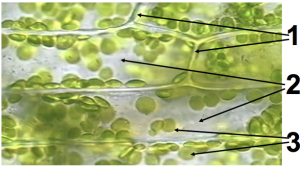
Part 1 is the cell wall. A wall is a key feature of plant cells, which have a cell wall outside of the cell membrane. The wall is made of cellulose (plant fiber) and provides plant cells with strength and rigidity. It’s cell walls that enable trees to tower hundreds of feet into the air.
Part 2 is the cytoplasm, the site of many of the cell’s chemical reactions.
The green spheres at 3 are chloroplasts. Chloroplasts are the organelles that perform photosynthesis, the process by which plants produce food using energy from the sun, carbon and oxygen atoms from carbon dioxide, and hydrogen atoms from water.
4b. Onion Cells
Another easy type of cell to observe is the cells in an onion.
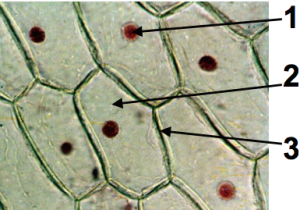
These cells, like the Elodea cells above, are surrounded by a cell wall, which you can see in number 3.
In the center of the cell, you can see the nucleus, shown at number 1. The nucleus, as described above, holds and protects the cell’s chromosomes. It appears red because it’s been stained to make it visible.
Surrounding the nucleus is the cytoplasm (2).
Even though these are plant cells, these onion cells don’t have chloroplasts. If you remember that these cells are from a part of a plant that is underground, you can figure out why.
4c.Potato Cells
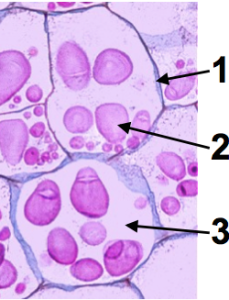 Here’s a cell from a potato. At number 1 you can observe the
Here’s a cell from a potato. At number 1 you can observe the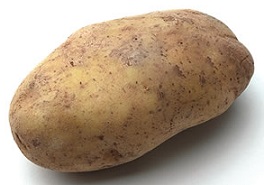 cell wall. Number 3 is the cytoplasm.
cell wall. Number 3 is the cytoplasm.
These cells have also been stained with iodine, but for a different reason than the onion cells above. When iodine is mixed with starch, it turns the starch purple. The purple spheres on the left (at number 2) are organelles called starch plastids. Their function is to store starch.
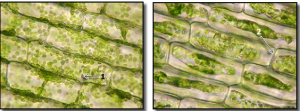
Note that in the potato, onion, and elodea cells, no membrane was visible. But that doesn’t mean that it wasn’t there. If a plant cell has enough water, its membrane gets pushed up against the wall, making the membrane invisible. You can only see the membrane when the cell becomes dehydrated (which you can see in the picture on the right side).
4d. Human Cheek Cells
Here’s a cell from an animal (a human being). These are cells from the inner cheek of the mouth.
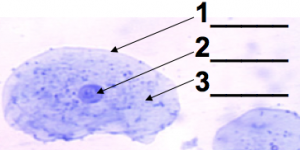 At number 1, you can see the membrane, which is the outer boundary of an animal cell. Number 2 is the nucleus, stained blue (with a DNA stain called methylene blue) to make it visible. Between the nucleus and the membrane is the cytoplasm (at number 3).
At number 1, you can see the membrane, which is the outer boundary of an animal cell. Number 2 is the nucleus, stained blue (with a DNA stain called methylene blue) to make it visible. Between the nucleus and the membrane is the cytoplasm (at number 3).
4e. Animal Sperm Cells
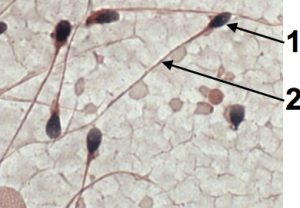 These cells are animal sperm cells. Sperm cells are highly specialized, and consist of a head (1), and a tail (2). The head consists mostly of a nucleus, carrying chromosomes from the male animal who made the sperm to an egg. The tail enables the sperm to swim.
These cells are animal sperm cells. Sperm cells are highly specialized, and consist of a head (1), and a tail (2). The head consists mostly of a nucleus, carrying chromosomes from the male animal who made the sperm to an egg. The tail enables the sperm to swim.
Got it? Try this quiz.
5. Basic Cell Parts and Cell Concepts Quiz
[qwiz random = “true” qrecord_id=”sciencemusicvideosMeister1961-cell-parts(AP)-Quiz”]
[h]Basic Cell Parts and Concepts Quiz
[i]This quiz will test your mastery of all the ideas in this tutorial. Here’s how the quiz works:
- Each question is multiple choice or matching, but the entire quiz is like a series of flashcards.
- If you get the question right, it comes off the deck.
- If you get the question wrong, it goes to the bottom of the deck, so you can try it again.
[q]Elodea Cells
[l]chloroplasts
[fx] No, that’s not correct. Please try again.
[f*] Correct!
[l]cytoplasm
[fx] No. Please try again.
[f*] Good!
[l]cell wall
[fx] No. Please try again.
[f*] Correct!
[q]Onion Cells (stained with iodine)
[l]cell wall
[fx] No. Please try again.
[f*] Excellent!
[l]cytoplasm
[fx] No. Please try again.
[f*] Excellent!
[l]nucleus
[fx] No. Please try again.
[f*] Good!
[q]Cells from a potato (stained with iodine)
[l]cell wall
[fx] No. Please try again.
[f*] Correct!
[l]cytoplasm
[fx] No. Please try again.
[f*] Excellent!
[l]starch plastid
[fx] No. Please try again.
[f*] Great!
[q]Cells from the inside of a human cheek
[l]cell membrane
[fx] No, that’s not correct. Please try again.
[f*] Good!
[l]cytoplasm
[fx] No, that’s not correct. Please try again.
[f*] Correct!
[l]nucleus
[fx] No, that’s not correct. Please try again.
[f*] Excellent!
[q]Animal Sperm Cells
[l]head/nucleus
[fx] No, that’s not correct. Please try again.
[f*] Excellent!
[l]tail (flagellum)
[fx] No, that’s not correct. Please try again.
[f*] Excellent!
[q] A student is observing cells under a microscope. The cells are extremely small. Doing further research, the student learns that the cells have DNA, but the DNA is not in a nucleus. There are no complex organelles. This cell would best be described as a
[c]YW5pbWFsIGNlbGw=[Qq]
[c]cHJva2FyeW90 aWMgY2VsbA==[Qq]
[c]cGxhbnQgY2VsbA==[Qq]
[f]wqBOby7CoEFuaW1hbCBjZWxscyBoYXZlIG9yZ2FuZWxsZXMgYW5kIGEgbnVjbGV1cy4=[Qq]
[f]IE5pY2Ugam9iOiBwcm9rYXJ5b3RpYyBjZWxscyBhcmUgc21hbGwgYW5kIG11Y2ggc2ltcGxlciB0aGFuIGV1a2FyeW90aWMgY2VsbHMuIFRoZXkgaGF2ZSBETkEsIGJ1dCBpdCYjODIxNztzIG5vdCBlbmNsb3NlZCBpbiBhIG51Y2xldXMuIFRoZXJlIGFyZSBubyBjb21wbGV4IG9yZ2FuZWxsZXMu[Qq]
[f]wqBOby4gUGxhbnQgY2VsbHMgaGF2ZSBvcmdhbmVsbGVzIGFuZCBhIG51Y2xldXMu
Cg==[Qq]
[q]A student is observing cells under a microscope. The cells have a cell wall, a nucleus, and chloroplasts. This cell must be a
[c]cGxhbnQg Y2VsbA==[Qq]
[c]YW5pbWFsIGNlbGw=[Qq]
[c]cHJva2FyeW90aWMgY2VsbA==[Qq]
[f]RXhjZWxsZW50LiBQbGFudCBjZWxsc8KgaGF2ZSBhIGNlbGwgd2FsbCwgYSBudWNsZXVzLCDCoGFuZCBjaGxvcm9wbGFzdHMu[Qq]
[f]wqBOby4gQW5pbWFsIGNlbGxzIGRvbiYjODIxNzt0IGhhdmUgY2VsbCB3YWxscy4=[Qq]
[f]IE5vLiBQcm9rYXJ5b3RpYyBjZWxscyBkb24mIzgyMTc7dCBoYXZlIGEgbnVjbGV1cyBvciBjb21wbGV4IG9yZ2FuZWxsZXMgbGlrZSBjaGxvcm9wbGFzdHMu
[q]A student is observing cells under a microscope. The cells are from a multicellular organism. The outer boundary of these cells is a cell membrane. There is a visible nucleus. There is no cell wall. These cells must be
[c]cGxhbnQgY2VsbHM=[Qq]
[c]YW5pbWFs IGNlbGxz[Qq]
[c]cHJva2FyeW90aWMgY2VsbHM=[Qq]
[f]Tm8uIFBsYW50IGNlbGxzwqBoYXZlIGEgY2VsbCB3YWxsLCBhIG51Y2xldXMsIMKgYW5kICh1c3VhbGx5KSBjaGxvcm9wbGFzdHMu[Qq]
[f]IFllcy4gQW5pbWFsIGNlbGxzIGRvbiYjODIxNzt0IGhhdmUgY2VsbCB3YWxscy4gVGhlaXIgb3V0ZXIgYm91bmRhcnkgaXMgdGhlIGNlbGwgbWVtYnJhbmUuIEFuZCB0aGV5IGhhdmUgYSBjbGVhcmx5IGRlZmluZWQgbnVjbGV1cy4=[Qq]
[f]wqBOby4gUHJva2FyeW90aWMgY2VsbHMgZG9uJiM4MjE3O3QgaGF2ZSBhIG51Y2xldXMu
[q]Which of the following statements about prokaryotic cells is TRUE?
[c]UHJva2FyeW90aWMgY2VsbHMgaGF2ZSBjaGxvcm9wbGFzdHM=[Qq]
[c]UHJva2FyeW90aWMgY2VsbHMgYXJlIHNtYWxs ZXIgdGhhbiBldWthcnlvdGljIGNlbGxzLg==[Qq]
[c]UHJva2FyeW90aWMgY2VsbHMgaGF2ZSBhIG51Y2xldXM=[Qq]
[f]Tm8uwqBQcm9rYXJ5b3RpYyBjZWxscyBkb24mIzgyMTc7dCBoYXZlIGNvbXBsZXggb3JnYW5lbGxlcyBsaWtlIGNobG9yb3BsYXN0cy4=[Qq]
[f]IFllcy7CoFByb2thcnlvdGljIGNlbGxzIGFyZSBzbWFsbGVyIHRoYW4gZXVrYXJ5b3RpYyBjZWxscy4=[Qq]
[f]wqBOby7CoFByb2thcnlvdGljIGNlbGxzIGRvbiYjODIxNzt0IGhhdmUgYSBudWNsZXVz
[q]Which of the following kinds of organisms have prokaryotic cells?
[c]QW5pbWFscw==[Qq]
[c]UGxhbnRzLg==[Qq]
[c]RnVuZ2k=[Qq]
[c]QmFjdG VyaWE=[Qq]
[f]Tm8uwqBBbmltYWxzIGhhdmUgZXVrYXJ5b3RpYyBjZWxscw==[Qq]
[f]Tm8uIFBsYW50cyBoYXZlIGV1a2FyeW90aWMgY2VsbHM=[Qq]
[f]wqBOby7CoEZ1bmdpIGhhdmUgZXVrYXJ5b3RpYyBjZWxscw==[Qq]
[f]WWVzLiBCYWN0ZXJpYSBoYXZlIHByb2thcnlvdGljIGNlbGxzLg==
Cg==[Qq]
[q]What’s the name for the barrier that surrounds the cytoplasm. It’s present in all cells.
[c]Y2VsbCB3YWxs[Qq]
[c]bnVjbGV1cw==[Qq]
[c]Y2VsbCBtZW 1icmFuZQ==[Qq]
[c]Y3l0b3BsYXNt[Qq]
[c]c3RhcmNoIHBsYXN0aWQ=[Qq]
[c]Y2hsb3JvcGxhc3Q=[Qq]
[f]Tm8uwqBDZWxsIHdhbGxzIGFyZSBmb3VuZCBvdXRzaWRlIHRoZSBjZWxsIG1lbWJyYW5lLg==[Qq]
[f]Tm8uIFRoZSBudWNsZXVzIGlzIHdoYXQgaG9sZHMgYW5kIHByb3RlY3RzIHRoZSBETkEgKGdlbmVzKSBpbiBhIGV1a2FyeW90aWMgY2VsbA==[Qq]
[f]WWVzLiBJbiBhbGwgY2VsbHMsIHRoZSBiYXJyaWVyIHRoYXQgc3Vycm91bmRzIHRoZSBjeXRvcGxhc20gaXMgdGhlIGNlbGwgbWVtYnJhbmUu[Qq]
[f]Tm8uIFRoZSBjeXRvcGxhc20gaXMgdGhlIGZsdWlkIGluc2lkZSB0aGUgbWVtYnJhbmUuIEl0JiM4MjE3O3Mgd2hlcmUgdGhlIGNlbGwmIzgyMTc7cyBjaGVtaWNhbCByZWFjdGlvbnMgb2NjdXIu[Qq]
[f]Tm8uIFN0YXJjaCBwbGFzdGlkcyBhcmUgb25seSBmb3VuZCBpbiBjZWxscyB0aGF0IHN0b3JlIHN0YXJjaCwgbGlrZSBwb3RhdG8gY2VsbHMuIFRoZXkmIzgyMTc7cmUgZm91bmQgZmxvYXRpbmcgaW5zaWRlIHRoZSBjeXRvcGxhc20u[Qq]
[f]Tm8uIENobG9yb3BsYXN0cyBhcmUgc21hbGwsIGdyZWVuIGVsbGlwdGljYWwgYm9kaWVzIGZvdW5kIGluc2lkZSB0aGUgY3l0b3BsYXNtIG9mIHBsYW50IGNlbGxzLiBUaGVpciBmdW5jdGlvbiBpcyB0byBwcm9kdWNlIGZvb2QgdGhyb3VnaCBwaG90b3N5bnRoZXNpcy4=
Cg==[Qq]
[q]What’s the name for the organelle inside the cytoplasm which holds the genes/DNA?
[c]Y2VsbCB3YWxs[Qq]
[c]bnVjbG V1cw==[Qq]
[c]Y2VsbCBtZW1icmFuZQ==[Qq]
[c]Y3l0b3BsYXNt[Qq]
[c]c3RhcmNoIHBsYXN0aWQ=[Qq]
[c]Y2hsb3JvcGxhc3Q=[Qq]
[f]Tm8uIFRoZSBjZWxsIHdhbGwgaXMgdGhlIG91dGVyIGJvdW5kYXJ5IG9mIGEgcGxhbnQgY2VsbC4gT25lIG9mIGl0cyBmdW5jdGlvbnMgaXMgdG8gcHJvdmlkZSBzdHJlbmd0aCBhbmQgcmlnaWRpdHkgdG8gdGhlIGNlbGwu[Qq]
[f]WWVzLiBUaGUgbnVjbGV1cyBpcyB3aGF0IGhvbGRzIGFuZCBwcm90ZWN0cyB0aGUgRE5BIChnZW5lcykgaW4gYSBldWthcnlvdGljIGNlbGw=[Qq]
[f]Tm8uIFRoZSBjZWxsIG1lbWJyYW5lIGlzwqB0aGUgYmFycmllciB0aGF0IHN1cnJvdW5kcyB0aGUgY3l0b3BsYXNtLiBJdCBjb250cm9scyB3aGF0IGVudGVycyBhbmQgbGVhdmVzIHRoZSBjZWxsLg==[Qq]
[f]Tm8uIFRoZSBjeXRvcGxhc20gaXMgdGhlIGZsdWlkIGluc2lkZSB0aGUgbWVtYnJhbmUuIEl0JiM4MjE3O3Mgd2hlcmUgdGhlIGNlbGwmIzgyMTc7cyBjaGVtaWNhbCByZWFjdGlvbnMgb2NjdXIu[Qq]
[f]Tm8uIFRoZSBmdW5jdGlvbiBvZiBzdGFyY2ggcGxhc3RpZHMgaXMgdG/CoHN0b3JlIHN0YXJjaC4gVGhleSYjODIxNztyZSBvbmx5IGZvdW5kIGluIGNlbGxzIGxpa2UgcG90YXRvIGNlbGxzLg==[Qq]
[f]Tm8uIENobG9yb3BsYXN0cyBhcmUgc21hbGwsIGdyZWVuIGVsbGlwc2VzIG9yIHNwaGVyZXMgZm91bmQgaW5zaWRlIHRoZSBjeXRvcGxhc20gb2YgcGxhbnQgY2VsbHMuIFRoZWlyIGZ1bmN0aW9uIGlzIHRvIHByb2R1Y2UgZm9vZCB0aHJvdWdoIHBob3Rvc3ludGhlc2lzLg==
Cg==[Qq]
[q]What’s the name for the fluid inside the cell where chemical reactions occur?
[c]Y2VsbCB3YWxs[Qq]
[c]bnVjbGV1cw==[Qq]
[c]Y2VsbCBtZW1icmFuZQ==[Qq]
[c]Y3l0b3 BsYXNt[Qq]
[c]c3RhcmNoIHBsYXN0aWQ=[Qq]
[c]Y2hsb3JvcGxhc3Q=[Qq]
[f]Tm8uIFRoZSBjZWxsIHdhbGwgaXMgdGhlIG91dGVyIGJvdW5kYXJ5IG9mIGEgcGxhbnQgY2VsbC4gT25lIG9mIGl0cyBmdW5jdGlvbnMgaXMgdG8gcHJvdmlkZSBzdHJlbmd0aCBhbmQgcmlnaWRpdHkgdG8gdGhlIGNlbGwu[Qq]
[f]Tm8uIFRoZSBudWNsZXVzIGlzIHdoYXQgaG9sZHMgYW5kIHByb3RlY3RzIHRoZSBETkEgKGdlbmVzKSBpbiBhIGV1a2FyeW90aWMgY2VsbA==[Qq]
[f]Tm8uIFRoZSBjZWxsIG1lbWJyYW5lIGlzwqB0aGUgYmFycmllciB0aGF0IHN1cnJvdW5kcyB0aGUgY3l0b3BsYXNtLiBJdCBjb250cm9scyB3aGF0IGVudGVycyBhbmQgbGVhdmVzIHRoZSBjZWxsLg==[Qq]
[f]WWVzLiBUaGUgY3l0b3BsYXNtIGlzIHRoZSBmbHVpZCBpbnNpZGUgdGhlIG1lbWJyYW5lLiBJdCYjODIxNztzIHdoZXJlIHRoZSBjZWxsJiM4MjE3O3MgY2hlbWljYWwgcmVhY3Rpb25zIG9jY3VyLg==[Qq]
[f]Tm8uIFRoZSBmdW5jdGlvbiBvZiBzdGFyY2ggcGxhc3RpZHMgaXMgdG/CoHN0b3JlIHN0YXJjaC4gVGhleSYjODIxNztyZSBvbmx5IGZvdW5kIGluIGNlbGxzIGxpa2UgcG90YXRvIGNlbGxzLg==[Qq]
[f]Tm8uIENobG9yb3BsYXN0cyBhcmUgc21hbGwsIGdyZWVuIGVsbGlwdGljYWwgc3BoZXJlcyBmb3VuZCBpbnNpZGUgdGhlIGN5dG9wbGFzbSBvZiBwbGFudCBjZWxscy4gVGhlaXIgZnVuY3Rpb24gaXMgdG8gcHJvZHVjZSBmb29kIHRocm91Z2ggcGhvdG9zeW50aGVzaXMu
Cg==[Qq]
[q]What’s the name for the organelle, found only in plant cells, that carries out photosynthesis?
[c]Y2VsbCB3YWxs[Qq]
[c]bnVjbGV1cw==[Qq]
[c]Y2VsbCBtZW1icmFuZQ==[Qq]
[c]Y3l0b3BsYXNt[Qq]
[c]c3RhcmNoIHBsYXN0aWQ=[Qq]
[c]Y2hsb3Jv cGxhc3Q=[Qq]
[f]Tm8uIFRoZSBjZWxsIHdhbGwgaXMgdGhlIG91dGVyIGJvdW5kYXJ5IG9mIGEgcGxhbnQgY2VsbC4gT25lIG9mIGl0cyBmdW5jdGlvbnMgaXMgdG8gcHJvdmlkZSBzdHJlbmd0aCBhbmQgcmlnaWRpdHkgdG8gdGhlIGNlbGwu[Qq]
[f]Tm8uIFRoZSBudWNsZXVzIGlzIHdoYXQgaG9sZHMgYW5kIHByb3RlY3RzIHRoZSBETkEgKGdlbmVzKSBpbiBhIGV1a2FyeW90aWMgY2VsbA==[Qq]
[f]Tm8uIFRoZSBjZWxsIG1lbWJyYW5lIGlzwqB0aGUgYmFycmllciB0aGF0IHN1cnJvdW5kcyB0aGUgY3l0b3BsYXNtLiBJdCBjb250cm9scyB3aGF0IGVudGVycyBhbmQgbGVhdmVzIHRoZSBjZWxsLg==[Qq]
[f]Tm8uIFRoZSBjeXRvcGxhc20gaXMgdGhlIGZsdWlkIGluc2lkZSB0aGUgbWVtYnJhbmUuIEl0JiM4MjE3O3Mgd2hlcmUgdGhlIGNlbGwmIzgyMTc7cyBjaGVtaWNhbCByZWFjdGlvbnMgb2NjdXIu[Qq]
[f]Tm8uIFRoZSBmdW5jdGlvbiBvZiBzdGFyY2ggcGxhc3RpZHMgaXMgdG/CoHN0b3JlIHN0YXJjaC4gVGhleSYjODIxNztyZSBvbmx5IGZvdW5kIGluIGNlbGxzIGxpa2UgcG90YXRvIGNlbGxzLg==[Qq]
[f]WWVzLiBDaGxvcm9wbGFzdHMgYXJlIHNtYWxsLCBncmVlbiBlbGxpcHNlcyBvZiBzcGhlcmVzIGZvdW5kIGluc2lkZSB0aGUgY3l0b3BsYXNtIG9mIHBsYW50IGNlbGxzLiBUaGVpciBmdW5jdGlvbiBpcyB0byBwcm9kdWNlIGZvb2QgdGhyb3VnaCBwaG90b3N5bnRoZXNpcy4=
Cg==[Qq]
[q]What’s the name for organelle, found only in plant cells, that provides plant cells with strength and rigidity?
[c]Y2VsbC B3YWxs[Qq]
[c]bnVjbGV1cw==[Qq]
[c]Y2VsbCBtZW1icmFuZQ==[Qq]
[c]Y3l0b3BsYXNt[Qq]
[c]c3RhcmNoIHBsYXN0aWQ=[Qq]
[c]Y2hsb3JvcGxhc3Q=[Qq]
[f]WWVzLiBUaGUgY2VsbCB3YWxsIGlzIHRoZSBvdXRlciBib3VuZGFyeSBvZiBhIHBsYW50IGNlbGwuIE9uZSBvZiBpdHMgZnVuY3Rpb25zIGlzIHRvIHByb3ZpZGUgc3RyZW5ndGggYW5kIHJpZ2lkaXR5IHRvIHRoZSBjZWxsLg==[Qq]
[f]Tm8uIFRoZSBudWNsZXVzIGlzIHdoYXQgaG9sZHMgYW5kIHByb3RlY3RzIHRoZSBETkEgKGdlbmVzKSBpbiBhIGV1a2FyeW90aWMgY2VsbA==[Qq]
[f]Tm8uIFRoZSBjZWxsIG1lbWJyYW5lIGlzwqB0aGUgYmFycmllciB0aGF0IHN1cnJvdW5kcyB0aGUgY3l0b3BsYXNtLiBJdCBjb250cm9scyB3aGF0IGVudGVycyBhbmQgbGVhdmVzIHRoZSBjZWxsLg==[Qq]
[f]Tm8uIFRoZSBjeXRvcGxhc20gaXMgdGhlIGZsdWlkIGluc2lkZSB0aGUgbWVtYnJhbmUuIEl0JiM4MjE3O3Mgd2hlcmUgdGhlIGNlbGwmIzgyMTc7cyBjaGVtaWNhbCByZWFjdGlvbnMgb2NjdXIu[Qq]
[f]Tm8uIFRoZSBmdW5jdGlvbiBvZiBzdGFyY2ggcGxhc3RpZHMgaXMgdG/CoHN0b3JlIHN0YXJjaC4gVGhleSYjODIxNztyZSBvbmx5IGZvdW5kIGluIGNlbGxzIGxpa2UgcG90YXRvIGNlbGxzLg==[Qq]
[f]Tm8uIENobG9yb3BsYXN0cyBhcmUgc21hbGwsIGdyZWVuIGVsbGlwdGljYWwgc3BoZXJlcyBmb3VuZCBpbnNpZGUgdGhlIGN5dG9wbGFzbSBvZiBwbGFudCBjZWxscy4gVGhlaXIgZnVuY3Rpb24gaXMgdG8gcHJvZHVjZSBmb29kIHRocm91Z2ggcGhvdG9zeW50aGVzaXMu
Cg==[Qq]
[q]In the diagram below, letter “A” is pointing to the
[c]Y2VsbCBtZW1icmFuZQ==[Qq]
[c]Y2VsbC B3YWxs[Qq]
[c]Y2hsb3JvcGxhc3Q=[Qq]
[c]Y3l0b3BsYXNt[Qq]
[c]c3RhcmNoIHBsYXN0aWQ=[Qq]
[c]bnVjbGV1cw==[Qq]
[f]Tm8uwqBUaGUgY2VsbCBtZW1icmFuZSBpcyBmb3VuZCBpbiBhbGwgY2VsbHMsIGJ1dCAmIzgyMjA7QSYjODIyMTsgaXMgcG9pbnRpbmcgdG8gdGhlIG91dGVyIGJvdW5kYXJ5IG9mIGEgcGxhbnQgY2VsbC4=[Qq]
[f]IFllcy7CoCYjODIyMDtBJiM4MjIxOyBpcyBwb2ludGluZyB0byB0aGUgY2VsbCB3YWxsLg==
[f]wqBOby4gQ2hsb3JvcGxhc3RzIGFyZSBzbWFsbCwgZ3JlZW4sIGVsbGlwdGljYWwgYm9kaWVzIGZvdW5kIGluc2lkZSBwbGFudCBjZWxscy4=[Qq]
[f]wqBOby4gVGhlIGN5dG9wbGFzbSBpcyB0aGUgY2xlYXIgbGlxdWlkIGZvdW5kIGluc2lkZSBjZWxscy4=[Qq]
[f]wqBOby7CoEEgc3RhcmNoIHBsYXN0aWQgaXMgYW4gb3JnYW5lbGxlIGZvdW5kIG9ubHkgaW4gY2VsbHMgdGhhdCBzdG9yZSBzdGFyY2gsIGxpa2UgYSBwb3RhdG8uIFdoZW4gc3RhaW5lZCB3aXRoIGlvZGluZSwgaXQgY2FuIGJlIHNlZW4gYXMgYSBwdXJwbGUgZWxsaXBzZSwgYW5kIHRoZXJlIGFyZSBtYW55IG9mIHRoZW0gaW5zaWRlIHRoZSBjZWxsLg==[Qq]
[f]wqBOby7CoFRoZSBudWNsZXVzIGlzIGluc2lkZSB0aGUgY3l0b3BsYXNtLiBXaGVuIHN0YWluZWQgd2l0aCBpb2RpbmUsIGl0IGNhbiBiZSBzZWVuIGFzIGFuIG9yYW5nZSBlbGxpcHNlLiBXaXRoIGZldyBleGNlcHRpb25zLCB0aGVyZSBpcyBvbmx5IG9uZSBudWNsZXVzIGluc2lkZSBlYWNoIGNlbGwu
Cg==[Qq]
[q]In the diagram below, letter “B” is pointing to the
[c]Y2VsbCBtZW1icmFuZQ==[Qq]
[c]Y2VsbCB3YWxs[Qq]
[c]Y2hsb3JvcGxhc3Q=[Qq]
[c]Y3l0b3 BsYXNt[Qq]
[c]c3RhcmNoIHBsYXN0aWQ=[Qq]
[c]bnVjbGV1cw==[Qq]
[f]Tm8uwqBUaGUgY2VsbCBtZW1icmFuZSBpcyBmb3VuZCBpbiBhbGwgY2VsbHMsIGJ1dCBpbiB0aGlzIHNldCBvZiBwaWN0dXJlcywgaXQmIzgyMTc7cyBvbmx5IHZpc2libGUgYXMgdGhlIG91dGVyIGJvdW5kYXJ5IG9mIGFuIGFuaW1hbCBjZWxsICh0aGUgY2hlZWsgY2VsbCku[Qq]
[f]Tm8uwqBUaGUgY2VsbCB3YWxsIGlzIHRoZSBvdXRlciBib3VuZGFyeSBvZiBhIHBsYW50IGNlbGwu[Qq]
[f]wqBOby4gQ2hsb3JvcGxhc3RzIGFyZSBzbWFsbCwgZ3JlZW4sIGVsbGlwdGljYWwgYm9kaWVzIGZvdW5kIGluc2lkZSBwbGFudCBjZWxscy4=[Qq]
[f]IFllcy4gVGhlIGN5dG9wbGFzbSBpcyB0aGUgY2xlYXIgbGlxdWlkIGZvdW5kIGluc2lkZSBjZWxscy4=[Qq]
[f]wqBOby7CoEEgc3RhcmNoIHBsYXN0aWQgaXMgYW4gb3JnYW5lbGxlIGZvdW5kIG9ubHkgaW4gY2VsbHMgdGhhdCBzdG9yZSBzdGFyY2gsIGxpa2UgYSBwb3RhdG8uIFdoZW4gc3RhaW5lZCB3aXRoIGlvZGluZSwgaXQgY2FuIGJlIHNlZW4gYXMgYSBwdXJwbGUgZWxsaXBzZS4gVGhlcmUgYXJlIG1hbnkgb2YgdGhlbSBpbnNpZGUgdGhlIGNlbGwu[Qq]
[f]wqBOby7CoFRoZSBudWNsZXVzIGlzIGluc2lkZSB0aGUgY3l0b3BsYXNtLiBXaGVuIHN0YWluZWQgd2l0aCBpb2RpbmUsIGl0IGNhbiBiZSBzZWVuIGFzIGFuIG9yYW5nZSBlbGxpcHNlLiBXaXRoIGZldyBleGNlcHRpb25zLCB0aGVyZSBpcyBvbmx5IG9uZSBudWNsZXVzIGluc2lkZSBlYWNoIGNlbGwu
Cg==[Qq]
[q]In the diagram below, letter “C” is pointing to the
[c]Y2VsbCBtZW1icmFuZQ==[Qq]
[c]Y2VsbCB3YWxs[Qq]
[c]Y2hsb3JvcGxhc3Q=[Qq]
[c]Y3l0b3BsYXNt[Qq]
[c]c3RhcmNoIH BsYXN0aWQ=[Qq]
[c]bnVjbGV1cw==[Qq]
[f]Tm8uwqBUaGUgY2VsbCBtZW1icmFuZSBpcyBmb3VuZCBpbiBhbGwgY2VsbHMsIGJ1dCBpbiB0aGlzIHNldCBvZiBwaWN0dXJlcywgaXQmIzgyMTc7cyBvbmx5IHZpc2libGUgYXMgdGhlIG91dGVyIGJvdW5kYXJ5IG9mIGFuIGFuaW1hbCBjZWxsICh0aGUgY2hlZWsgY2VsbCku[Qq]
[f]Tm8uwqBUaGUgY2VsbCB3YWxsIGlzIHRoZSBvdXRlciBib3VuZGFyeSBvZiBhIHBsYW50IGNlbGwu[Qq]
[f]Tm8uIENobG9yb3BsYXN0cyBhcmUgc21hbGwsIGdyZWVuLCBlbGxpcHRpY2FsIGJvZGllcyBmb3VuZCBpbnNpZGUgcGxhbnQgY2VsbHMu[Qq]
[f]Tm8uIFRoZSBjeXRvcGxhc20gaXMgdGhlIGNsZWFyIGxpcXVpZCBmb3VuZCBpbnNpZGUgY2VsbHMu[Qq]
[f]WWVzLsKgQSBzdGFyY2ggcGxhc3RpZCBpcyBhbiBvcmdhbmVsbGUgZm91bmQgb25seSBpbiBjZWxscyB0aGF0IHN0b3JlIHN0YXJjaCwgbGlrZSBhIHBvdGF0by4gV2hlbiBzdGFpbmVkIHdpdGggaW9kaW5lLCBpdCBjYW4gYmUgc2VlbiBhcyBhIHB1cnBsZSBlbGxpcHNlLiBUaGVyZSBhcmUgbWFueSBvZiB0aGVtIGluc2lkZSB0aGUgY2VsbC4=[Qq]
[f]wqBOby7CoFRoZSBudWNsZXVzIGlzIGluc2lkZSB0aGUgY3l0b3BsYXNtLiBXaGVuIHN0YWluZWQgd2l0aCBpb2RpbmUsIGl0IGNhbiBiZSBzZWVuIGFzIGFuIG9yYW5nZSBlbGxpcHNlLiBXaXRoIGZldyBleGNlcHRpb25zLCB0aGVyZSBpcyBvbmx5IG9uZSBudWNsZXVzIGluc2lkZSBlYWNoIGNlbGwu
Cg==[Qq]
[q]In the diagram below, letter “D” is pointing to the
[c]Y2VsbCBtZW1icmFuZQ==[Qq]
[c]Y2VsbCB3YWxs[Qq]
[c]Y2hsb3Jv cGxhc3Q=[Qq]
[c]Y3l0b3BsYXNt[Qq]
[c]c3RhcmNoIHBsYXN0aWQ=[Qq]
[c]bnVjbGV1cw==[Qq]
[f]Tm8uwqBUaGUgY2VsbCBtZW1icmFuZSBpcyBmb3VuZCBpbiBhbGwgY2VsbHMsIGJ1dCBpbiB0aGlzIHNldCBvZiBwaWN0dXJlcywgaXQmIzgyMTc7cyBvbmx5IHZpc2libGUgYXMgdGhlIG91dGVyIGJvdW5kYXJ5IG9mIGFuIGFuaW1hbCBjZWxsICh0aGUgY2hlZWsgY2VsbCku[Qq]
[f]Tm8uwqBUaGUgY2VsbCB3YWxsIGlzIHRoZSBvdXRlciBib3VuZGFyeSBvZiBhIHBsYW50IGNlbGwu[Qq]
[f]WWVzLiBDaGxvcm9wbGFzdHMgYXJlIHNtYWxsLCBncmVlbiwgZWxsaXB0aWNhbCBib2RpZXMgZm91bmQgaW5zaWRlIHBsYW50IGNlbGxzLg==[Qq]
[f]Tm8uIFRoZSBjeXRvcGxhc20gaXMgdGhlIGNsZWFyIGxpcXVpZCBmb3VuZCBpbnNpZGUgY2VsbHMu[Qq]
[f]Tm8uwqBBIHN0YXJjaCBwbGFzdGlkIGlzIGFuIG9yZ2FuZWxsZSBmb3VuZCBvbmx5IGluIGNlbGxzIHRoYXQgc3RvcmUgc3RhcmNoLCBsaWtlIGEgcG90YXRvLiBXaGVuIHN0YWluZWQgd2l0aCBpb2RpbmUsIGl0IGNhbiBiZSBzZWVuIGFzIGEgcHVycGxlIGVsbGlwc2UuIFRoZXJlIGFyZSBtYW55IG9mIHRoZW0gaW5zaWRlIHRoZSBjZWxsLg==[Qq]
[f]wqBOby7CoFRoZSBudWNsZXVzIGlzIGluc2lkZSB0aGUgY3l0b3BsYXNtLiBXaGVuIHN0YWluZWQgd2l0aCBpb2RpbmUsIGl0IGNhbiBiZSBzZWVuIGFzIGFuIG9yYW5nZSBlbGxpcHNlLiBXaXRoIGZldyBleGNlcHRpb25zLCB0aGVyZSBpcyBvbmx5IG9uZSBudWNsZXVzIGluc2lkZSBlYWNoIGNlbGwu
Cg==[Qq]
[q]In the diagram below, letter “E” is pointing to the
[c]Y2VsbCBtZW1icmFuZQ==[Qq]
[c]Y2VsbCB3YWxs[Qq]
[c]Y2hsb3JvcGxhc3Q=[Qq]
[c]Y3l0b3BsYXNt[Qq]
[c]c3RhcmNoIHBsYXN0aWQ=[Qq]
[c]bnVjbG V1cw==[Qq]
[f]Tm8uwqBUaGUgY2VsbCBtZW1icmFuZSBpcyBmb3VuZCBpbiBhbGwgY2VsbHMsIGJ1dCBpbiB0aGlzIHNldCBvZiBwaWN0dXJlcywgaXQmIzgyMTc7cyBvbmx5IHZpc2libGUgYXMgdGhlIG91dGVyIGJvdW5kYXJ5IG9mIGFuIGFuaW1hbCBjZWxsICh0aGUgY2hlZWsgY2VsbCku[Qq]
[f]Tm8uwqBUaGUgY2VsbCB3YWxsIGlzIHRoZSBvdXRlciBib3VuZGFyeSBvZiBhIHBsYW50IGNlbGwu[Qq]
[f]Tm8uIENobG9yb3BsYXN0cyBhcmUgc21hbGwsIGdyZWVuLCBlbGxpcHRpY2FsIGJvZGllcyBmb3VuZCBpbnNpZGUgcGxhbnQgY2VsbHMu[Qq]
[f]Tm8uIFRoZSBjeXRvcGxhc20gaXMgdGhlIGNsZWFyIGxpcXVpZCBmb3VuZCBpbnNpZGUgY2VsbHMu[Qq]
[f]Tm8uwqBBIHN0YXJjaCBwbGFzdGlkIGlzIGFuIG9yZ2FuZWxsZSBmb3VuZCBvbmx5IGluIGNlbGxzIHRoYXQgc3RvcmUgc3RhcmNoLCBsaWtlIGEgcG90YXRvLiBXaGVuIHN0YWluZWQgd2l0aCBpb2RpbmUsIGl0IGNhbiBiZSBzZWVuIGFzIGEgcHVycGxlIGVsbGlwc2UuIFRoZXJlIGFyZSBtYW55IG9mIHRoZW0gaW5zaWRlIHRoZSBjZWxsLg==[Qq]
[f]WWVzLsKgVGhlIG51Y2xldXMgaXMgaW5zaWRlIHRoZSBjeXRvcGxhc20uIFdoZW4gc3RhaW5lZCB3aXRoIGlvZGluZSwgaXQgY2FuIGJlIHNlZW4gYXMgYW4gb3JhbmdlIGVsbGlwc2UuIFdpdGggZmV3IGV4Y2VwdGlvbnMsIHRoZXJlIGlzIG9ubHkgb25lIG51Y2xldXMgaW5zaWRlIGVhY2ggY2VsbC4=
Cg==[Qq]
[q]In the diagram below, letter “F” is pointing to the
[c]Y2VsbCBtZW 1icmFuZQ==[Qq]
[c]Y2VsbCB3YWxs[Qq]
[c]Y2hsb3JvcGxhc3Q=[Qq]
[c]Y3l0b3BsYXNt[Qq]
[c]c3RhcmNoIHBsYXN0aWQ=[Qq]
[c]bnVjbGV1cw==[Qq]
[f]WWVzLsKgVGhlIGNlbGwgbWVtYnJhbmUgaXMgZm91bmQgaW4gYWxsIGNlbGxzLCBidXQgaW4gdGhpcyBzZXQgb2YgcGljdHVyZXMsIGl0JiM4MjE3O3Mgb25seSB2aXNpYmxlIGFzIHRoZSBvdXRlciBib3VuZGFyeSBvZiBhbiBhbmltYWwgY2VsbCAodGhlIGNoZWVrIGNlbGwpLg==[Qq]
[f]Tm8uwqBUaGUgY2VsbCB3YWxsIGlzIHRoZSBvdXRlciBib3VuZGFyeSBvZiBhIHBsYW50IGNlbGwu[Qq]
[f]Tm8uIENobG9yb3BsYXN0cyBhcmUgc21hbGwsIGdyZWVuLCBlbGxpcHRpY2FsIGJvZGllcyBmb3VuZCBpbnNpZGUgcGxhbnQgY2VsbHMu[Qq]
[f]Tm8uIFRoZSBjeXRvcGxhc20gaXMgdGhlIGNsZWFyIGxpcXVpZCBmb3VuZCBpbnNpZGUgY2VsbHMu[Qq]
[f]Tm8uwqBBIHN0YXJjaCBwbGFzdGlkIGlzIGFuIG9yZ2FuZWxsZSBmb3VuZCBvbmx5IGluIGNlbGxzIHRoYXQgc3RvcmUgc3RhcmNoLCBsaWtlIGEgcG90YXRvLiBXaGVuIHN0YWluZWQgd2l0aCBpb2RpbmUsIGl0IGNhbiBiZSBzZWVuIGFzIGEgcHVycGxlIGVsbGlwc2UuIFRoZXJlIGFyZSBtYW55IG9mIHRoZW0gaW5zaWRlIHRoZSBjZWxsLg==[Qq]
[f]wqBOby7CoFRoZSBudWNsZXVzIGlzIGluc2lkZSB0aGUgY3l0b3BsYXNtLiBXaGVuIHN0YWluZWQgd2l0aCBpb2RpbmUsIGl0IGNhbiBiZSBzZWVuIGFzIGFuIG9yYW5nZSBlbGxpcHNlLiBXaXRoIGZldyBleGNlcHRpb25zLCB0aGVyZSBpcyBvbmx5IG9uZSBudWNsZXVzIGluc2lkZSBlYWNoIGNlbGwu
Cg==[Qq]
[x]If you want to take this quiz again, please click the button below.
[restart]
[/qwiz]
Next
- Animal Cells: Parts and Functions (the next tutorial about cells)
